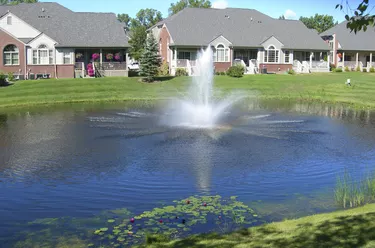
Planned unit developments are residential communities that include both private residences and shared public space. A planned unit development, or PUD, has a special zoning classification that allows construction techniques that wouldn't be permitted elsewhere. The residents pay dues to fund maintenance and construction of public areas. All of these features make buying a home in a PUD different from buying property elsewhere, and home buyers should research a PUD carefully before investing there.
Convenience and Accessibility
Video of the Day
Convenience is one of the primary advantages of a planned unit development. Many PUDs use a layout that features clusters of homes and large open spaces or commercial areas. These areas can include shops, parks, recreational facilities and restaurants, so residents don't need to leave the development to reach basic goods and services. PUDs often include extensive sidewalks and wide roads or bicycle paths, making it convenient to get around the development by multiple means.
Video of the Day
Cost vs. Maintenance Fees
Planned unit developments offer homes in a wide range of prices so that residents of many income levels can find a place to live in a PUD. However, while the variety of prices is an advantage, the fees residents pay can be one of a PUD's biggest drawbacks. Residents are required to pay regular fees for maintenance of the common areas in the development, but the actual decisions about how to spend this money are left to a homeowners association board of directors. Those decisions may or may not reflect the actual priorities of residents.
Social Consequences
One of the special zoning aspects of a PUD is the ability to build dwellings closer together, producing population densities that would be a violation of zoning regulations elsewhere. Thus, residents are likely to be very close to neighbors without the buffer zone of a yard that would exist in a more traditional suburban setting. PUD residents also share public spaces like parks and recreation areas, providing more time to socialize with neighbors but also reducing opportunities for privacy.
Regulations Help or Harm
Planned unit developments have their own sets of regulations that all residents must follow. These regulations are set and enforced by the homeowners association board, and they vary from one PUD to another. Some of these are positive, like requiring guests to check in after a certain hour or requiring all cars parked on the roads to be registered with the homeowners association. These regulations enhance security and protect residents. Other regulations regarding quiet hours, pets, home appearances and use of public spaces may seem more like an imposition to residents used to a lifestyle with fewer regulations.
Buying and Selling
Buying and selling homes in a planned unit development can be very different, and sometimes more difficult, than doing so elsewhere. While a PUD's amenities may make it more attractive to some buyers, a PUD with multiple available units can drive down the price and make it harder to sell. Buying in a PUD can also be a problem, with some lenders treating units in a PUD differently for mortgage purposes. Such differentiation could complicate the buying process or reduce a buyer's access to low mortgage rates.